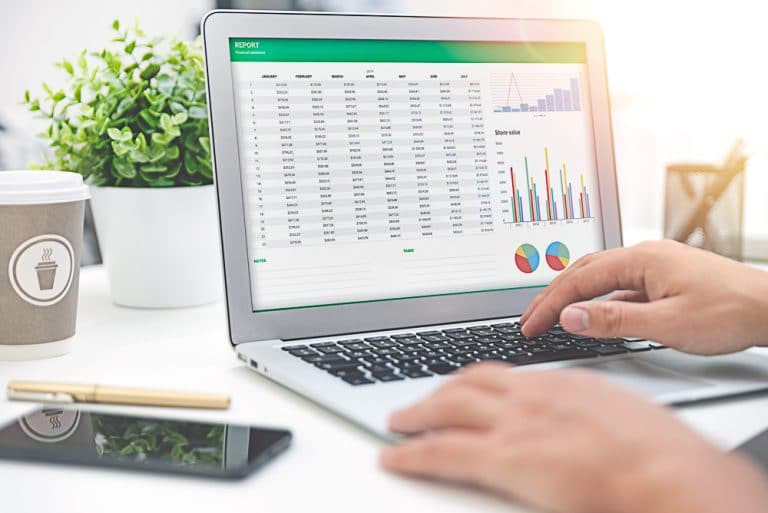How to Budget Irregular Income and Brings Some Predictability to Your Cash Flow
This website may earn commissions from purchases made through links in this post.

Getting by on an irregular income is all about managing CASH FLOW. When the cash flows in, you need to manage it in a way that there is enough to cover the months when the cash isn’t flowing in so freely.
When I worked in an accounting firm, I often worked with farmers on their cash flow budgets. If anyone has an irregular income, it’s a farmer. They often have months of no income while they wait for harvest time (assuming there are no floods, fires or droughts!).
Now, as someone who is self-employed, my income is also super irregular. I get paid monthly (sometimes late!), and it’s a challenge covering upcoming expenses when you have no idea how much money you’ll earn from one month to the next. But there are a few tactics that can help cover future costs.
One way to keep track of whether you can meet current and future expenses is to keep a cash flow budget.
A cash flow budget tracks ALL the money you receive (flowing in) and the money you have to pay (flowing out). It also tracks WHEN the money comes in and needs to be paid out.
Before you read further, check out the article on how I make a super simple budget, as well as how I create a yearly cash flow budget in Excel.
Disclaimer: This is general information only. In this blog, I share my savings and budget planning and what works for us. You should always consult a qualified financial expert when making money decisions (not a random stranger on the internet like me – or even your mate at the pub).
Irregular Income? Pay Yourself Like an Employee
One way to smooth out an irregular income is to draw down a regular allowance from your irregular earnings, leaving the extra (from the good months) as savings to cover the lean months.
This is called income smoothing.
If your irregular income comes from being self-employed, then it’s a good idea to have a SEPARATE BANK ACCOUNT for your business.
When you’re self-employed, it’s easy for the lines between business and personal to blur, BUT it’s so much easier to keep your business and your personal expenses separate if you use separate bank accounts. Your accountant will love you for it.
Not only does a separate bank account make business bookkeeping easier, but you can also pay yourself a regular ‘wage’, therefore eliminating the irregular income problem. Not a formal payroll wage, but regular drawings from your business income that provide you with a steady, regular source of income, making it easier to budget.
These drawings should be calculated from your business profits, not revenue, so you have money to cover business expenses. That means you work out your regular drawings after taking into account your business expenses, your superannuation and tax.
What if you aren’t self-employed, but your income is still irregular? Maybe you work casual hours, and you’re not sure how many hours you’ll work from week to week.
You can apply the same principle. You can use a separate account for your irregular income and withdraw a regular amount that you use for spending. The weeks where you work more should (hopefully*) cover the weeks when you work less, effectively smoothing out your income.
*Keeping a cash flow budget can help you track this to make sure.
How much should you withdraw each week?
Your budget is your blueprint to guide you. Here’s how to create a cash flow budget (similar to the ones linked above) when you have an irregular income.
Start Your Cash Flow Budget by Writing Down Your Expenses
Rather than starting your budget with how much you earn, start by analysing your living expenses so you know how much you NEED to earn over the course of a year.
Look at your bank and credit card statements from the past year to get an idea of your spending. You can also do an expense-tracking exercise to see how much you normally spend and on what.
When you have a ballpark figure of your yearly expenses, you can total up all your expected irregular income to see if it will cover your projected expenses.
Prioritise your expenses into those that must be paid every month and discretionary expenses that can be cut if your income won’t cover them.
Also, write down the TIMING of your expenses. If you pay your car registration once a year, in which month do you pay it? If your electricity is quarterly, what months does it fall due?
Rather than guessing expenses, put them into your budget for the month that they fall due. This way, you know which months you’re going to need extra cash or how long you’ve got to save up for each expense.
Using an envelope-type system can help you save for expenses. Similar to income-smoothing, putting aside a regular amount each pay for each expense helps you smooth your bills over a longer period and reduces bill shock when they fall due.
Add Your Predicted Income to Your Cash Flow Budget
There are several ways that you can budget your predicted income:
- If you have had irregular income in the past, base this year’s income on last year’s, adjusting it for any known changes.
- If your work is seasonal, then you will have some idea of which months bring in a higher income than others.
- You could predict your income as per the amount of work that you reasonably expect to generate and the terms of trade that you intend to offer (ie, 30-day accounts etc). Be conservative in this estimation; it’s better to underestimate than to overestimate your income. If you’re new to irregular income, then maybe ask others in the same line of work what they earned in their first year and again give a conservative estimate.
- Managing cash flow will be easier if you can predict how much income you expect in which month. That will give you an indication in advance of which months will be lean. For example, my earnings regularly increase just before Christmas, whereas my friend works casually in a school, and she gets no work over Christmas. Knowing this helps both of us budget for the ups and downs.
- If you get a base salary plus a commission, you could budget according to the base salary and consider any commission a bonus.
- As the year progresses, you may get a better indication of your income patterns. Adjust your budget accordingly.
Total Up Your Year’s Worth of Income and Expenses
Some months your income will be higher than your expenses. Other months your expenses will be higher. But will you have enough income over the course of a year to cover all of your expenses?
By totalling up a year’s worth of income and expenses, you’ll be able to see if your irregular income can cover your expenses.
Update your budget regularly
You want to create a living cash flow that you update regularly. Updating your budget by putting in your actual income and expenses each month will give you a much more accurate picture of whether you will be able to adequately meet future expenses and will allow your budgets to be more accurate in future years.
At the end of each month, adjust the budget to accurately reflect the month’s actual income and expenses. Notice how these changes affect the overall cash flow. Do you still have a positive total yearly cash flow? Does your savings cover any deficit?
Also, adjust your budget to reflect changes in your predicted income or expenses. Your spending patterns in August may not reflect your predictions made in January. Life changes. The more you adjust your budget to accurately reflect this, the more useful a tool it becomes.
More tips on budgeting with an Irregular Income – Create a Slush Fund
The most important tool when budgeting for irregular income is your savings account. Without funds put aside to tide you over in the lean months, you will be relying on debt to pay the bills. And debt can make the troughs of an irregular income even harder to manage.
How much you should aim to put aside in your slush fund will depend on your circumstances, but 2 – 3 months’ worth of expenses can give you peace of mind. Your slush fund is there to even out the peaks and troughs in your income.
Don’t forget to build an emergency fund on top of your slush fund for unexpected expenses.
Have a plan for the income that you earn beyond your slush fund amount. This extra cash might go to debt repayment, home deposit, holidays or splurges.
Finally, consider a sanity allowance both for the good months and the bad so that the temptation to splurge isn’t as strong when cash comes in. A sanity allowance is an allowance you give yourself to be spent however you like, guilt-free.
It can be harder to plan and budget with an irregular income. But there are strategies you can put in place to even out the peaks and troughs and claim a little more predictability for your budget.






